You all know the V-taper look. It’s the familiar and desirable sculpted physique with large, strong shoulders, a broad chest, washboard abs, and a toned core. Even the lapels on men’s suits are designed to taper in a way that complements an athletic man’s upper body. From bodybuilders and Greek statues to distinguished gentlemen, athletes, and fitness enthusiasts, the V-taper look has been sought-after for years. Since a great deal of dedication and discipline is necessary to develop this look, there’s also an air of appreciation and admiration for those who actually achieve it. Here’s the down-low on how to get the V-taper look, the importance of nutrition and body fat composition, and the best exercises to add to your training program.
What is the V-taper look?

The V-taper look refers to a muscular, strong, and defined physique. The V refers to the inverted triangle, or V-shape, of the upper body where a broad, wide upper back, shoulders, and traps taper down to a narrowing of the torso and waist with strong, sculpted abdominal muscles. Some experts believe that the V-taper look might be appealing on a psychological level because it signifies fertility, strength, and good genetics (there’s a reason most superheroes have the V-taper look). In the fitness world, it’s the visual gold standard of athleticism and masculinity that exemplifies the desirable proportions and symmetry of the upper body.
Building a strong foundation

Your first step in obtaining the V-taper look is to build a strong foundation. The tight waistline, bulging arms, well-developed back, and symmetrical upper body appearance take time and effort. You’ll need to boost the size and strength of specific muscles and alter your body fat composition over time. It requires a particular approach to nutrition alongside training specific muscle groups, such as the deltoids, lats, and obliques. It also requires a balance of fat loss and muscle development and plenty of sleep, which promotes overall wellness.
Can anyone get the V-taper physique?
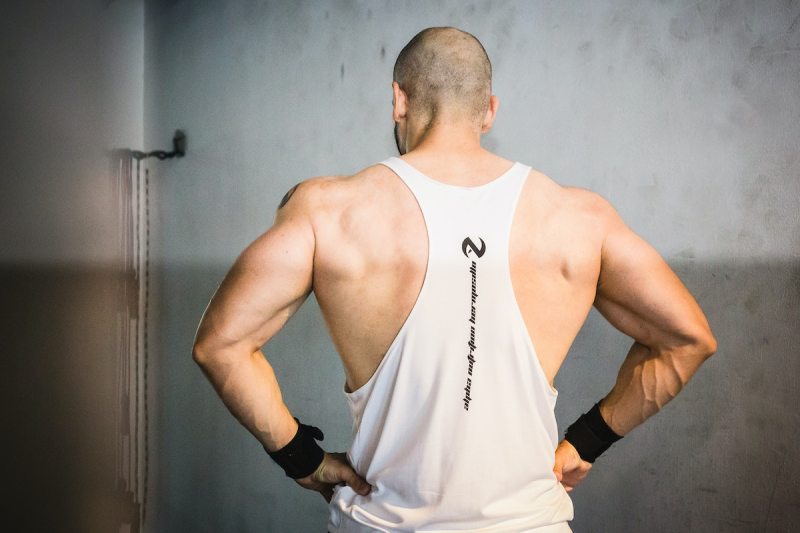
Genetics plays a role, so achieving the V-taper physique is more difficult for some. Due to these factors, not everyone will look the same, but with the right strategic nutrition and exercise program, you will reap the rewards of your efforts over time as you continue to build muscular strength, definition, and stamina.
The importance of nutrition and body fat composition
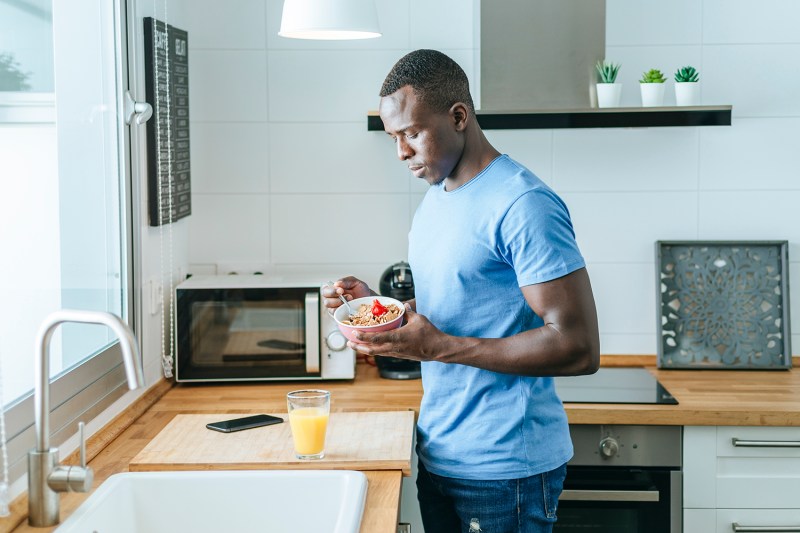
The better the quality of your food and the more nutrients you get, the more energy you’ll have to power through workouts and recover after each session. Bodybuilders and fitness enthusiasts have different approaches to nutrition, with varying macronutrient intakes, supplements, and carb and calorie counts. Factors like exercise, stress, toxicity, and diet are all involved with weight loss and body fat composition and should all be considered. A junk food diet won’t generate the same results as a nutrient-dense, well-formulated nutrition plan.
For example, eating sugar prompts your body to release the insulin hormone to safely carry the sugar away into your cells and prevent dangerously high blood sugar levels. However, insulin is also your fat-storage hormone that tells your body to store your body fat, so every time you eat a bunch of sugar, the insulin also instructs your body to hold on to fat. To reiterate, the more you eat sugar and foods that turn to sugar in your body, the more you increase your body fat levels, which conceals your abs and prevents optimal muscle definition. Research has shown that added sugar and fructose are among the worst culprits when it comes to increasing belly fat. You can ask your doctor, healthcare provider, or nutritionist if you have any questions about healthy eating.
Does eating more protein grow more muscle?

You need to ensure you’re eating the right amount of healthy protein to fuel muscle growth and repair. Protein builds muscle tissue, and it’s an essential part of a healthy, balanced diet.
What muscle groups should you target?

Your training program should focus on developing your shoulders, back, arms, and waist muscles.
Shoulders
Exercises like lateral raises and overhead presses can help you target the deltoids in your shoulders to work on the broader “top part” of the V-shape.
Back
You’ll also need to develop your back muscles with heavy pulling and rowing movements like bent-over dumbbell rows. Wider lat muscles in your back create the appearance of a smaller waist. Work your lats with moves like pull-ups, chin-ups, and rows. For the best results, add lifts and exercises to target your rhomboids and muscles in your lower back.
Chest
A powerful chest contributes to a larger and wider upper part of the V-taper look. Target your pecs with exercises like bench presses, chest flies, and incline and decline presses.
Arms
You don’t want to forget those bulging arms, so you’ll need to incorporate isolation exercises like bicep curls and overhead triceps extensions to target your biceps and triceps.
Waist
While genetics are involved in your waist size, you can also consume a disciplined fat-loss-appropriate diet, work on your posture, and incorporate core exercises like planks, side planks, and hanging leg raises to trim your waistline and chisel your abs. Core moves also enhance your overall stability so you can continue to maximize gains safely.
Tips to achieve the V-shape
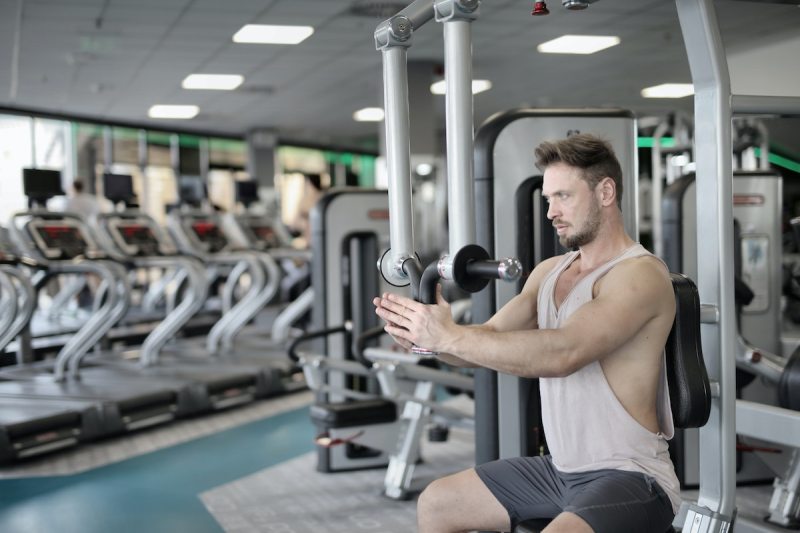
Here are some top tips to achieve the jaw-dropping superhero V-shape:
- Remember to prioritize proper form and technique.
- Master your form before trying heavier weights.
- Stay motivated by reminding yourself why you’re working so hard.
- Set clear and realistic goals.
- Listen to your body.
- Remind yourself that it takes time to see results, and it doesn’t happen overnight
- Celebrate every small success and reward yourself with that new workout gear you’ve been wanting.
- Find an accountability partner to share in your journey.
- You can use a fitness tracker if you find it helps, or try to log your progress in your notepad on your phone.
- Bring variety into your workouts to keep it interesting.
- Set smaller, more attainable milestones, such as enhancing your upper back size first or strengthening your biceps.
The best exercises to build the V-taper physique

The main focus of these exercises is to build strength and stamina and enhance your overall athletic performance to get you closer to achieving your goals. You should include compound and isolation exercises and implement progressive overload, where you gradually increase the weight, intensity levels, or repetitions to challenge your muscles and ramp up muscle hypertrophy. Try to make sure you warm up before strength training and allow your muscles sufficient time to recover between sessions.
Pull up
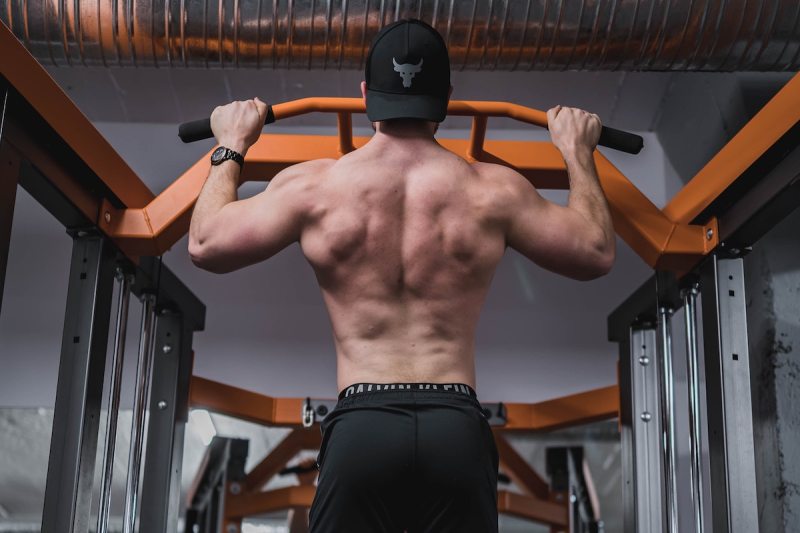
Pull-ups made it on our V-taper exercise list because you can really develop your lats with this move. Your lats are the largest muscle in your back, and performing pull-ups requires balance, strength, and flexibility in your back, shoulders, arms, and core. Beef up your upper body with this bodyweight pulling exercise.
How to perform pull-ups:
- Grip the pull-up bar with your hands shoulder-distance apart.
- Pull your entire body up to the bar until your chin is level with or just over the bar.
- Lower yourself back down with control until you reach the starting position.
- Repeat until you complete the set.
Dips
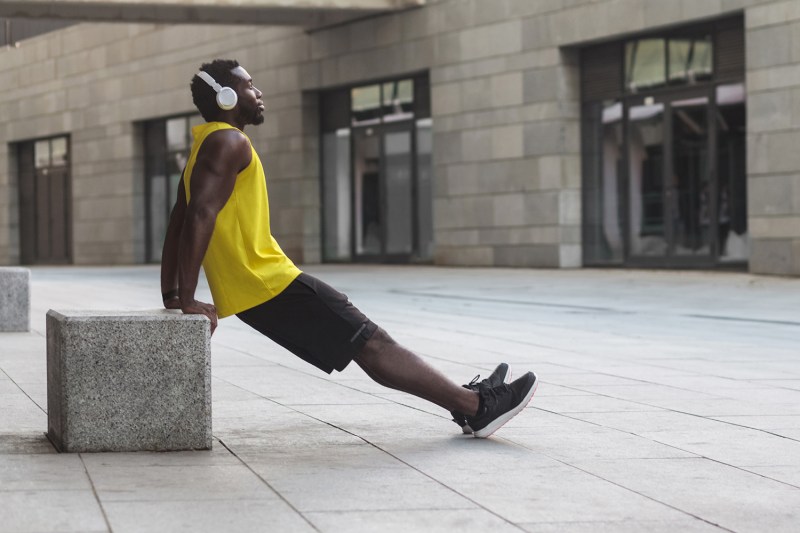
The tricep dip is favorable when you want to chisel that upper body and create a wider back, shoulders, and chest with bigger arms. You use the strength of your triceps and arm muscles to hoist your body weight up and down again. You’ll also target your trapezius muscles in your upper back and neck, core, and deltoids. All you need is a chair or a bench, and you’re good to go.
Here’s how to perform the tricep dip using parallel bars:
- Stand between the parallel bars and grip the bars with your elbows bent.
- Lift your body up vertically while straightening your arms.
- Lower your body down with control by bending your elbows until your arms are roughly at a 90-degree angle and parallel to the floor. Avoid flaring out your elbows, and try to keep them tucked in closer to your body.
- Try to keep your torso upright and your core engaged.
- Push down through your hands and lift your body back up again by straightening your arms.
- Repeat until you complete the set.
Deadlift

The deadlift is a classic and advanced compound weightlifting exercise that really helps you build a wider and stronger back and shoulders. You’ll engage your legs, knees, ankles, back, hips, shoulders, and wrists. The deadlift is a killer workout for your lats, traps, rhomboids, erectors in your mid back, and more.
How to perform deadlifts:
- Stand with your feet about hips-distance apart and with the bar over the middle of your feet.
- Lean forward and grip the bar with an overhand grip.
- Ensure your shoulders are pulled back, and your arms are straight.
- Brace your core and lift the bar.
- Pull the bar up close to your body until you’re standing straight.
- Carefully lower the bar down to the ground.
- Repeat until you complete the set.
Dumbbell lateral raise

The lateral raise isolates the lateral head of your deltoid muscle for broader and stronger shoulders. You can try this move with a cable machine, a resistance band, or dumbbells.
How to do a dumbbell lateral raise:
- With your arms by your sides, hold one dumbbell in each hand and slightly lean forward into the starting position.
- Slowly lift the dumbbells outwards until your arms are straight out by your sides, your upper arms are parallel with the floor, and you’re standing with your back straight.
- Slowly lower the dumbbells back to the starting position.
- Repeat until you complete the set.
Arnold Press

Of course, the seven-time Mr. Olympia winner, Arnold Schwarzenegger, is known for his muscular V-shaped physique and his ability in his prime for incredible lifts. The Arnold Press targets all three deltoid muscles in your shoulders, including the often-overlooked rear deltoid. You’ll also work your pectoral muscles in your upper chest, triceps in your upper arms, and trapezius muscles in your back. You can perform the Arnold Press sitting down or standing up with two dumbbells.
How to do the Arnold Press:
- Stand with your feet about shoulder distance apart and hold two dumbbells.
- Engage your core and bring the dumbbells up to shoulder height with your palms facing you.
- Engage your shoulders and pull your shoulder blades together.
- Extend your arms above your head while rotating your wrists to the front.
- At the top of the movement, you should hold the dumbbells above your head with your palms facing forward.
- Carefully lower the dumbbells back to the starting position by rotating your wrists. Your palms should face you again.
- Repeat until you complete the set.
One-arm dumbbell row
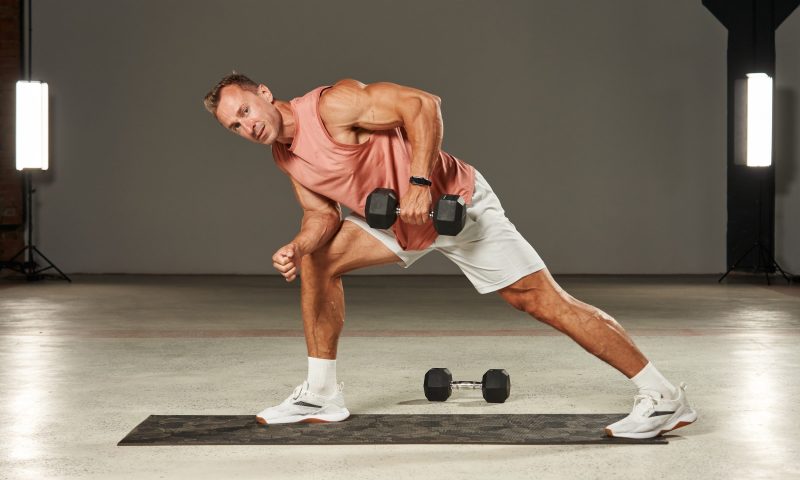
The dumbbell row sculpts your major back muscles, including your rhomboids, traps, and lats, and hits your biceps, shoulders, forearms, and core muscles like your obliques. The one-arm dumbbell row is an excellent exercise for enhancing your upper body power.
How to do the one-arm dumbbell row:
- Start in a lunge position with your left foot forward and your right foot back.
- Hold the dumbbell in your right hand.
- Lift or pull the weight up to your chest, keeping your elbow bent at a 90-degree angle.
- Try to engage your core throughout this movement.
- Lower the weight back down.
- Repeat until you complete the set.
Lateral pulldowns

The lateral pulldown is another superior pulling exercise for targeting your lats. You’ll also work your biceps, rear deltoids, and shoulders and improve your grip strength. Pulling the bar down emphasizes serious growth and development of your lats. You can use a cable machine to perform this move, either seated or standing up.
How to perform lat pulldowns:
- Pipe the bar with a wide overhand grip (slightly wider than shoulder distance apart) from a seated position.
- Keep your chest up and pull the bar down towards your chest.
- You should feel your shoulder blades squeezing together as the bar reaches your chest.
- Slowly release the bar back up.
- Repeat until you complete the set.
Hanging leg raise

The hanging leg raise levels up your overall athletic performance. Research has shown the hanging leg raise targets your abdominal muscles and creates over 88% maximum voluntary contraction (MVC) in the external obliques and over 130% in the rectus abdominis. While it’s important to bulk up your back and shoulders, you’ll also need to trim the waistline and carve those abdominals with moves like the hanging leg raise. You’ll need something to hang on to to complete this movement, such as a pull-up bar or power tower.
Here’s how to do a hanging leg raise:
- Stand in the captain’s chair frame with your arms on the padded armrests. If the handles are available, hold them.
- Try to keep your back straight and your arms stable.
- Engage your core.
- With a slight bend in your knees, lift your legs until your thighs parallel the ground.
- Carefully lower your legs back to the starting position.
- Repeat until you complete the set.
Additional V-taper exercises
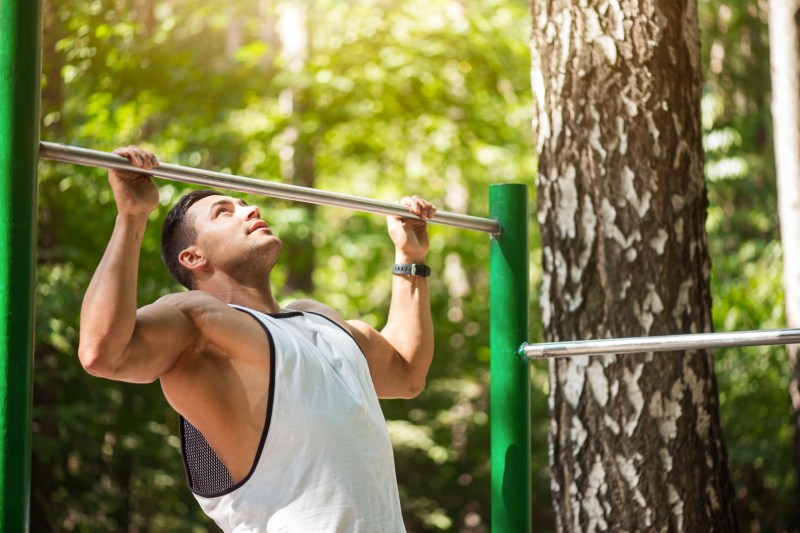
Here are some additional V-taper exercises to add to your routine:
- Chin up
- Squats
- Overhead press
Achieving this timeless silhouette undoubtedly takes hard work, persistence, dedication, and the right nutrition and training approach. Still, it’s certainly worth it for those who want to resemble a Greek statue.




